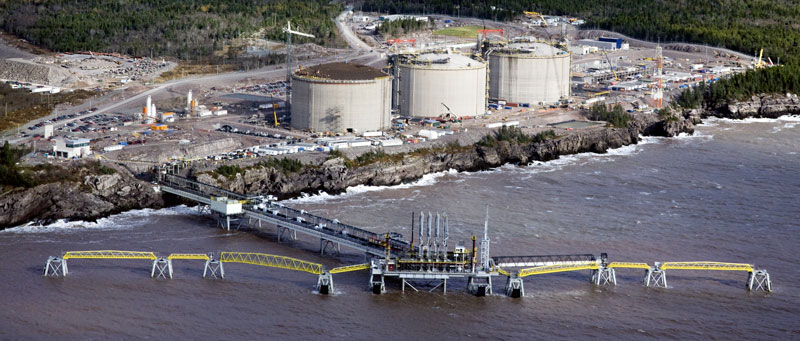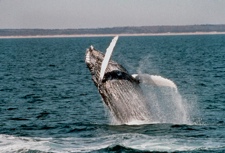
LNG Marine Terminal and Multi-Purpose Pier EIA Review
Scope of the assessment
The scope of the assessment was in accordance with the factors laid out by both the Clean Environment Act and the CEAA. The scope of this project was the construction, operation and decommissioning of the LNG receiving, storage and processing facility, as well as the receiving and transfer of Orimulsion to storage tanks at the Canaport facility.
The factors that were included in the scope assessment of the project were: alternatives to the project, alternative means of carrying out the project, description of the existing environment, environmental effects, mitigation measures, significance of residual effects, public consultation, monitoring and follow up programs, and the capacity of renewable resources that are likely to be significantly affected by the project. More specifically, the environmental impact assessment methods involved the following steps: scoping of issues and selection of valued ecosystem components (VECs), establishment of boundaries and residual environmental effects rating criteria, identification of the past, present, and future projects, identification of the environmental effects, an analysis and prediction of the significance of environmental effects, and the evaluation of the need for follow-up.
The process of carrying out the scoping included consultation with individuals, interests groups, local residents, government, and other stakeholders. This consultation was conducted in order to identify and take into account any issues and concerns that these groups voiced. There were many methods used in order to foster public participation but these will be evaluated in another section.
Overall the scoping was quite well done. It was clear that Jacques Whitford Limited and the host of associates with whom they worked jointly on the project, have a lot of experience in this realm and offered an expert report. However, one major criticism is the minimal focus that was placed on cumulative effects; there are ten other major projects in the area. While questions were posed concerning possible cumulative impacts they did not seem to be adequately considered. It was however noted in the EIS that the cumulative effects would not be significant.
The Selection of Valued Ecosystem Components - VECs based on public input, the professional judgement of the Project team and the consultants hired by Irving.
Résumé Environmental Impacts
Below you will find a complete list of the issues considered in the environmental impact analysis and a brief overview of their respective concerns. Some of these concerns are addressed in more details in physical and biological impacts, geo-social impacts, and socio-economic impacts.
Atmospheric environment
 This component is delimited approximately by a 10 km layer from the earth’s surface and is described by the climate, the air and sound quality. The Atmospheric Environment was chose as a Valued Ecosystem Component due to his inherent and fundamental role in the health and quality of life of human beings and the fauna and flora. Moreover the project is likely to produce some air contaminants, noise, dust, gas emissions and somewhat affect the climate of the region. Air is the predominant pathway for pollutants or contaminants to freshwater, terrestrial and humans.
This component is delimited approximately by a 10 km layer from the earth’s surface and is described by the climate, the air and sound quality. The Atmospheric Environment was chose as a Valued Ecosystem Component due to his inherent and fundamental role in the health and quality of life of human beings and the fauna and flora. Moreover the project is likely to produce some air contaminants, noise, dust, gas emissions and somewhat affect the climate of the region. Air is the predominant pathway for pollutants or contaminants to freshwater, terrestrial and humans.
Below are the principal issues concerning atmospheric environment:
- Air Quality: the effects on local and regional habitat (Saint John & New Brunswick); Industrial source of air contaminants, particulate matter, volatile organics compounds, cumulative effects of greenhouse gases, long-range transport of air pollutants (LRTAP), are the main issues studied.
- Sound Quality: outdoor sound quality affected by operation of heavy equipment, traffic, landscape and meteorological conditions. Sound pressure level, duration, frequency of noisy activities.
- Climate: impact and interaction on climate and weather condition, effect on the Bay the Fundy. Including precipitation, wind, sunshine hours and season’s transition.
Ground water

Groundwater was chose as a Valued Ecosystem Component since the project could possibly disrupt or pollute the water supply for the residents living in the proximity of the pipeline (Red Head Road area).
Here are the major concerns regarding the groundwater quality:
- potential for disruption or contamination of the water supply of residents along Red Head Road and near the pipeline
- presence of permeable material altering shallow groundwater
- degradation of the quality of water (sedimentation, turbidity, change of pH, etc.)
- management of waste water
- potential interaction with petroleum product (fuel , LNG , natural gas)
- reduction of the level of the aquifer and the recoverable groundwater
Marine environment

Marine environment can be defined as the marine flora and fauna (including endangered species) and their habitat. According to the EIA report, the marine zone incorporated the proposed terminal area (from Saint John Harbour to the entrance of the shipping lanes) and the Bay of Fundy.
Here are the majors concerns regarding the marine environment:
- effect on fish and their habitat, marine birds and mammals and marine traffic
- evaluation of the water quality and the risk of a spill or release of LNG on the Bay of Fundy ecosystem
- potential impact in particular on the North Atlantic right whale, the Atlantic salmon and the Lobster
- decline in abundance or alteration of the distribution of the population
- construction could cause: an increasing turbidity of the water, removal of benthic organism and habitat, alteration of the seabed, sedimentation and deposit, etc.
- LNG spill cause an elevation in the methane level (can result in asphyxiation of marine mammal) and a decrease of the surface water temperature.
Freshwater Fish & Fish Habitat

Freshwater fish refers to fish that stay during a part of their lifetime into freshwater environment (including invertebrate). Fish habitat refers to spawning, nursery and feeding grounds, food supplies and migration location for fish and other organism necessary to the fish.
Below are the main issues concerning freshwater fish and fish habitat:
- net loss of fish habitat and unrecovered condition within five years
- reduction of the wealth, abundance and diversity of fish community
- alteration of fish habitat, erosion and sedimentation, gravel deposit into streams. removal of vegetation; cutting and pruning trees will reduce shading and cover.
- noise level can cause stress on fish reproduction (blasting, explosion, excavation…).
Terrestrial & Wetland

Terrestrial environment can be defined as the land-based habitat and wildlife (excluding migratory bird, see below). According to New Brunswick Clean Environment Act, wetland can be defined as " areas of marsh, fen, peatland or water, whether natural or artificial, permanent or temporary, with water that is static or flowing, fresh, brackish or salt, including areas of marine water the depth of which at low tide does not exceed six meters." The EIA report stated that the lands cleared for the project site are assumed to be a permanent habitat loss; however the land on which the pipeline between the LNG tank and the Irving refinery are considered as a change in habitat type (from forest to open field).
Here are the major issues regarding Terrestrial and Wetland areas:
- change or decline in distribution of rare plant and/or animal community
- habitat fragmentation or permanent loss of habitat for endangered species. construction activities and pipeline installation create a temporary boundary to wildlife accentuating stress on wetland habitat (which is already a fragile habitat)
- loss of wood turtle habitat
- increased vehicle traffic (noise, air & contaminant)
Migratory birds

According to the EIA report, concerned migratory birds are the one that pass a least a part of their life cycle in the project vicinity and they are listed in the Migratory Birds Convention Act. The bird habitat boundary embraces the limits of clearing for the LNG facilities, the Bay of Fundy and the pipeline pathway, which is the area between the LNG tank and the Irving refinery.
Below are the main issues concerning migratory birds:
- Decline or disturbance in the distribution and abundance of migratory bird population (especially in the regions of Fundy Coast Eco-region and Bay of Fundy)
- Avoidance of the project area by marine migratory bird
- Noise and light can disorientate and distract bird resulting in bird mortality
- marine vessel accidents, hazardous material spill, forest fire
- destruction or disturbance of highly productive habitat for waterfowl breeding (wetland & ponds).
Commercial Fisheries

It includes the commercial fishing activity adjacent to the project site (outer Saint John Harbour to entrance of the shipping lanes). The EIA reported all vessels actually and/or seasonally in activity in the project vicinity and the economic value for each of them (total catch and market value).
Here have been compiled a list of concerns about commercial fishing:
-
 Restricted area and exclusion zone can interfere with the commercially licensed area of some fisherman resulting in a discontinuity of economical fishing activities for a season or more (financial difficulty for the fisherman of the region)(socio-economic impact)
Restricted area and exclusion zone can interfere with the commercially licensed area of some fisherman resulting in a discontinuity of economical fishing activities for a season or more (financial difficulty for the fisherman of the region)(socio-economic impact)
- temporary no access to specific fishing ground
- spill and accident can degrade the quality of water and result in a decline of fish resources
- damage of fishing gear.
Health and Safety

Obviously Health & Safety was selected as a VEC due to the potential risk to the public and workers related to LNG accidents, spills, emissions, leak, malfunctions and unplanned events.
The principals concerns of the public and workers concerning Health and Safety are the following:
- Accidents involving human’s injury (public and worker), loss of human’s life or permanent injury resulting in loss of life quality
- marine tanker spill, vehicle traffic-related accident
- pollution of environment (atmospheric, groundwater, marine, terrestrial, etc.)
- worker health can be affected by noise, dust , hazardous material and construction related hazard
- catastrophic failure, malfunctioning, marine and terrestrial spill and/or leak, emissions, accidents.
Land use

The EIA report evaluate the possible change in the use of lands in the vicinity of the project area while taking into consideration the property values, insurance, air contaminant, noise, visual aesthetics and risk of accidents. It includes the land off-site but in proximity of the project (Red Head Road, Mispec point, Bay of Fundy, view from Mispec Beach, etc.).
Below are the majors concerns regarding land use:
- disruption and/or alteration of present land use (discontinuity of activities without any compensation)
- construction activity generate an augmentation of the traffic (land and marine traffic)
- air pollutant, dust, noise and emission generated by construction can affect residential and public land uses (tourism, public park, recreation activities, etc.)
- removal of buffer vegetation zone that act like a visual barrier as well as a natural filtration (visual impact)
- temporary limited access to properties
- concerns of the population regarding an increase of their insurance rate and decrease of the property values due to the presence of the pipeline and/or the LNG facility.
Archaeological Heritage Resources

Archaeological and heritage resources refers to any physical remnants on and or below ground (including sea floor) that permit us to understand human history and interaction with the environment (Architectural site, historic place, paleontological resources, etc.). The EIA report recognized Archaeological Heritage resources as a VEC to reflect the potential impact on the First Nations, the population in general and provincial and federal agencies of historical conservation.
Majors concerns:
- Destruction or disturbance of archaeological or heritage resource considered of major importance (due to its rarity, undisturbed condition, spiritual importance or research importance, etc.)
- impact on gravel beach terrace (western edge of the project site)
- impact on the three known shipwrecks off the Mispec coast
- impact on the world war II bunkers at Mispec Point
- potentially interesting paleontological resources in the bedrock near the project site
- accidental groundbreaking, erosion or damage of heritage resource.
Aboriginal Land & Resource Use

The EIA evaluate the probability of environment effect on the land and resources actually used for traditional purpose by First Nations groups and Aboriginal communities.
The report stated there will be no interaction between the proposed project and this VEC since there are currently no Aboriginal uses in the vicinity of the project. Irving still continues to discuss with the Aboriginal communities in the region (Union of New Brunswick Indians, First Nations Groups) to get frequent update of the situation.
Road Transportation Network

The EIA report considered the concerns raised about providing a safe transportation in the area for the public and the workers as well as keeping the Red Head Road secure for every users with regard of the rise of related traffic. The EIA report focused on the Red Head Road and its feeder roads where the impact are more likely to occurs.
Here have been compiled a list of concerns about road transportation network:
- Excessive use of the Red Head Road could influence the rate erosion and result in loss of land on the shoreline
- construction required extensive variety of equipment, materials and employees to be all transport on the diverse project location
- impacts of potentially high traffic level and the correlation with vehicular accidents.
Labour & Economy

Labour can be defined as the direct employment linked to the project and the indirect creation of interrelated jobs in other sectors; while economy can be describe as the local and provincial spin-off benefits from the project and the labour income generated.
The EIA report states that the whole project will result in a positive impact on the economy and would result in employment and economic growth. Decommissioning and abandonment will create jobs as well. Accident or malfunction could result in temporary closure of the facility however the EIA propose an employment insurance and re-employment program to mitigate this impact.
Vessel Navigation

The EIA report evaluate the marine traffic in the shipping lanes (for LNG tankers) and in Saint John Harbour (both LNG and Orimulsion tankers) in the selected area (from the end of the shipping lanes to the pier at the Canaport facility). The vessel navigation related to the project is considered relatively low comparing to the overall commercial harbor traffic (8%).
Concern regarding Vessel Navigation:
- High vessel traffic could lead to accident and release of hazardous contaminant into the environment
- disruption of the marine vessel movement
- change in vessel access in the Port of Saint John due to heavy traffic in the area
- impact of exclusion zone on local fishers
- catastrophic failure of LNG vessel tanker.
Effect of Environment on Project

According to the Canadian Environmental Assessment Act, an environmental effect is defined as a change affecting the project that is caused by the environment. It comprise severe weather, climate change, acid rain and acid fog, forest fires, seismic activity and Red Head Road slope stability.
Major concern:
- Long term interruption of service
- change in the project schedule
- damage to infrastructure endangering public health and safety
- damage to infrastructure that could not be repaired due to technical or economical feasibility
- weather condition altering the stability of the ground and subsequently causing flooding, slope failure, erosion, sedimentation, etc.